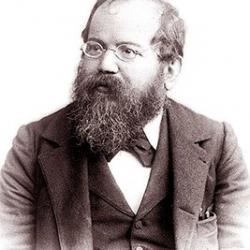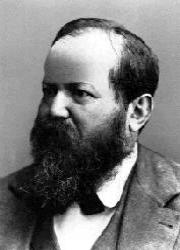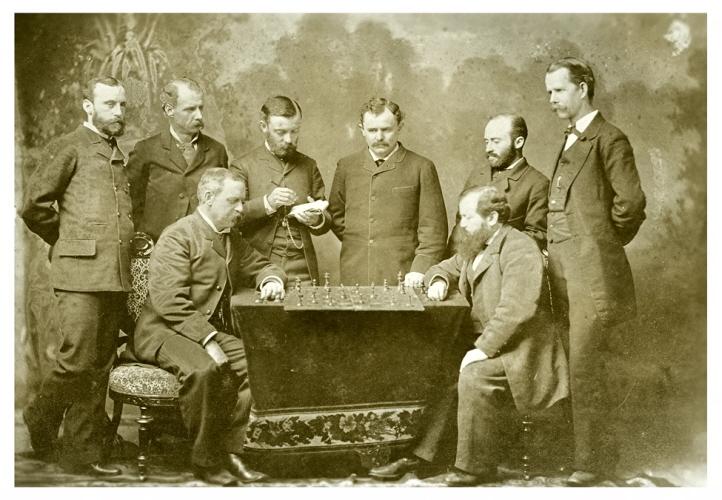Wilhelm Steinitz

Bio
Wilhelm Steinitz was an Austrian master and the first official world champion. He held the title from 1886-1894, after dominating the chess scene for decades before. He was undefeated in match play for over 30 years (1862-1894). In 1859-1961, bold attacking performances in the Vienna City Championships earned him the nickname "Austrian Morphy". From 1873-1882, Steinitz went on a historic 25 game winning streak. In the early 1870s he introduced a new style of play, and is subsequently regarded as the father of positional chess.
- Style
- From Early Life to Chess Professional
- Rise to Prominence
- Top Player in the World
- First Official World Champion
- Life after the Championship
- Legacy
Style
When Steinitz entered the chess scene in the 1850s, aggressive play was all the rage. He played in this romantic fashion full of gambits and sacrifices at first, but he later changed the landscape of chess forever when he revealed a new positional style of play. He defended his new positional ideas furiously, and they were eventually accepted by many other masters. This new positional style laid the groundwork for modern chess.
In 1873, when he was already the number one player in the world, Steinitz started proving his new theories over the board. He displayed many positional elements of the game that are still recognized today: the importance of a sound pawn structure, space, the bishop pair, creating and utilizing outposts for knights, and the accumulation of small advantages. Here is an early example of Steinitz' positional ideas where he splits Anderssen's queensides pawns, accumulates small advantages, and then uses a space advantage to outmaneuver his opponent and ultimately transform his positional advantage into material:
Early Days to Chess Professional
Steinitz learned to play chess at the age of 12, but did not take the game seriously until he was in his twenties. In 1859, Steinitz placed 3rd in the Vienna city championships. In 1861, he placed first in the same tournament, with a score of 30/31 points. Here is a brilliant attacking game by Steinitz from this time period - after sacrifices galore the game explodes into tactics that eventually leave Steinitz' queen and knights running rampant:
After this dominating performance in the 1861 Vienna tournament, Steinitz was asked to represent Austria in the London tournament of 1862. He placed sixth in his international debut, and immediately after the tournament he challenged Dubois (the 5th place finisher in London) to a match. Steinitz defeated Dubois 5.5-3.5, and his 32 year winning streak in matches began. After this first victory, he decided to become a chess professional and moved to London.
Rise to Prominence
Steinitz continued his match success in 1862-1863 by defeating Blackburne, a top English master. In 1863, he also defeated the English masters Deacon and Mongredien in matches. In 1864, Steinitz defeated another English master, Valentine Green. These match victories led to Steinitz being recognized as one of the top players in the world.
In 1866, Steinitz played a match with Adolf Anderssen. Anderssen was regarded as the top player in the world, as he had won the prestigious London tournaments of 1851 and 1862. The only player who was considered stronger than Anderssen was Morphy, who had retired from chess by 1866. Steinitz was definitely considered the underdog in this match, but he surprised the world when he defeated Anderssen by a score of 8-6.

After winning this match, Steinitz was viewed as the top player in the world. In the following game from the Anderssen match, Steinitz conducts an attack reminiscent of a modern King's Indian defense (almost 90 years before the King's Indian defense was modernized and popular following the 1953 Zurich international tournament):
Top Player in the World
In 1866, Steinitz defeated Bird in a match. He would not play another serious match until 1872, when he would face Johannes Zukertort - who was coming off of a convincing match victory against Anderssen in 1871, and would be Steinitz' eventual challenger for the first official world championship 14 years later. Steinitz defeated Zukertort in the 1872 match by a score of 9-3 (7 wins, 4 draws, 1 loss). This would be the last time that Steinitz would use the "old" style of aggressive tactics and romantic sacrifices.
In 1873, Steinitz competed in the Vienna tournament and displayed his new positional ideas. He tied for first with Blackburne, ahead of Anderssen, Rosenthal, Paulsen, and Bird. He defeated Blackburne in the playoff to take the first place prize. It was in this tournament that Steinitz won 14 games in a row, which would be the beginning of his 25 game win streak (another historic feat). This winning streak would extend from the 1873 Vienna tournament through the first two rounds of the 1882 Vienna tournament.
After the Vienna tournament in 1873, Steinitz withdrew from tournament play until 1882. He did defeat Blackburne in a match 7-0 in 1876, but besides this he was focused far more on writing about chess than playing it. He became a chess journalist for a London's leading sports magazine at the time. While writing for this magazine, he and Zukertort had many debates in their respective writing positions (Zukertort wrote for his self-published chess magazine).

Steinitz' comeback at the Vienna tournament in 1882 was successful - he shared first place with Winawer, ahead of Mason, Zukertort, Blackburne, Paulsen, Chigorin and others. In late 1882, he traveled to the United States where he defeated Sellman in two matches and defeated the Cuban Champion, Golmayo, in 1883.
Steinitz returned to London for the 1883 tournament, where he finished in second place behind Zukertort. After his long absence from international competitions and Zukertort's win at the London 1883 tournament, it was suggested that Zukertort was now the world's strongest player. Steinitz moved to the United States (where he would spend the rest of his life) after the London tournament in 1883, but his debates with Zukertort and others in magazines and journals continued. After lengthy negotiations, Steinitz and Zukertort agreed to terms for a match.
First Official World Champion
The Steinitz - Zukertort match of 1886 would be the first to decide an official world champion. The format for this match would be the first to ten wins. Steinitz had a terrible start to the match, and after five games Zukertort led by a score of 4-1. Then the match had a complete reversal, as Steinitz mounted a comeback for the ages. The final score was 12.5-7.5 (10 wins, 5 losses, 5 draws) in favor os Steinitz. The results of this match put an end to any debate regarding who was the top player at the time, and Steinitz was crowned the first official world champion.

In 1889, Steinitz would play Chigorin (a well-respected top player and Russian master). The match was sponsored by the Havana chess club, and Steinitz won again. The score was 10.5-6.5 (10 wins, 6 losses, 1 draw), and Steinitz' undefeated match record grew to 27 years. Here is a game example from this match where Steinitz uses positional and tactical themes to conduct an aesthetically pleasing attack:
In 1890, Steinitz would play Isidor Gunsberg for the title. Gunsberg had placed 3rd in the 1889 New York tournament (Chigorin tied for first with Weiss) to earn the right to face Steinitz. Steinitz defeated Gunsberg by a score of 10.5-8.5 (6 wins, 4 losses, 9 draws). In 1892, Steinitz would have a re-match with Chigorin for the world championship. The score was closer this time, but the results were the same: Steinitz defeated Chigorin by a score of 12.5-10.5 (10 wins, 8 losses, 5 draws).
It appeared that nobody on the planet could defeat Steinitz, and his undefeated match record had achieved the 30 year mark; an almost unbelievable feat! But in 1894, a newcomer who was relatively untested in match play sent Steinitz a challenge - Emanuel Lasker. Lasker had some recent tournament successes, but had not played Chigorin or Tarrasch (the recognized 2nd and 3rd best players in the world at the time) in a match. It should be noted that Tarrasch had declined a match invitation from both Lasker and Steinitz in the early 1890s.

The chess world felt that Lasker stood little to no chance of defeating Steinitz, and Steinitz was on record as saying that he would win without a doubt. Then the young Lasker performed what seemed to be a miracle, as he defeated Steinitz in the 1894 World Championship match by a convincing score of 12-6 (10 wins, 5 losses, 4 draws). This was not only Steinitz' first match loss ever, but it ended his 32 year undefeated match streak while simultaneously removing the championship crown from Steinitz' head.
Life After the World Championship
Steinitz continued playing after the loss to Lasker. He won the 1894 tournament in New York, and won the brilliancy prize in 1895 in Hastings (this famous game can be found below, under the "Best Game" section). In the 1895 St. Petersburg tournament he finished in second place behind Lasker, but ahead of Chigorin and Pillsbury.
From late 1896 to early 1897, Steinitz had a rematch with Lasker for the world championship. Lasker won even more convincingly than in their first match, by a score of 12.5-4.5 (10 wins, 2 losses, 5 draws). He would play in two more tournaments after the rematch with Lasker, but his results had noticeably declined. Steinitz passed away in 1900, at the age of 64 (the same number of squares that are on a chess board).
Legacy
Steinitz' legacy is enormous. His 32 years of undefeated match play is staggering. It is difficult to compare this achievement to anything current, as matches are much less rare nowadays when compared to tournaments. Steinitz' historic 25 game winning streak from 1873-1882 is another mind-bending accomplishment. Most people don't believe that it is fair to compare this winning streak to Bobby Fischer's 20 game winning streak from 1970-1971, as Fischer's streak had no long interruptions and was against absolute top class competition. At any rate, Steinitz' winning streak is beyond impressive.
Steinitz was also a celebrated author and publicist. His debates and arguments with Zukertort and others via magazines and journals are historical. Steinitz' contributions to opening theory were integral to the development of openings that are still popular today. His life and games are still studied in books, videos, and articles. Steinitz' largest contribution to chess was definitely his part in the development of positional and strategical play.

Perhaps it was the third world champion, Capablanca, who summarized Steinitz best: "It was Steinitz who was the first to establish the basic principles of general chess strategy. He was a pioneer and one of the most profound researchers into the truth of the game, which was hidden from his contemporaries". It is for his amazing accomplishments over the board, his original and groundbreaking ideas about positional play, and the fact that he was the first official world champion that Steinitz will always be remembered as the outstanding chess legend that he is.


